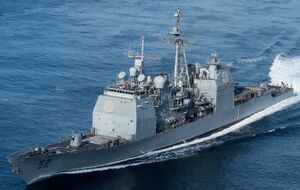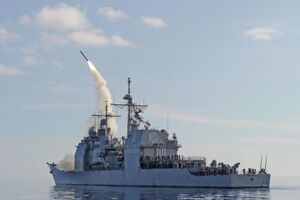Salsu-class guided-missile cruiser
 KHMS Salsu
| |
| Class overview | |
|---|---|
| Name: | Salsu class |
| Builders: | Hyundai Heavy Industries Co.,Ltd. |
| Operators: |
|
| Preceded by: | Guiju-class |
| Succeeded by: | Myeongnyang-class |
| Cost: | $1 Billion |
| Built: | 1992-1997 |
| In commission: | 1993–present |
| Planned: | 12 |
| Completed: | 10 |
| Cancelled: | 2 |
| Active: | 6 |
| Lost: | 0 |
| General characteristics | |
| Type: | Guided-missile cruiser |
| Displacement: | 9,800 t full load |
| Length: | 173 m |
| Beam: | 16.8 m |
| Draft: | 10.2 m |
| Propulsion: | |
| Speed: | 32.5 knots (60 km/h; 37.4 mph) |
| Range: | 6,000 nmi (11,000 km) |
| Sensors and processing systems: |
|
| Electronic warfare & decoys: | LIG Nex1 SLQ-200K Sonata electronic warfare suite |
| Armament: |
|
| Aircraft carried: | 2 × Anti-Submarine helicopters |
Salsu-class guided-missile cruisers are cruisers operated by Royal Joseon Navy. It was constructed from 1992 to 1997, 6 of which are still active. Salsu-class is also the Royal Joseon Navy's first Aegis system-equipped vessel.
Salsu-class cruisers were built as part of a plan to address the growing anxiety over multipolarity, which hit Joseon's society right after the end of the Cold War. The Salsu-class is considered in many ways a copy of United States' Ticonderoga-class cruiser.
History
When the Soviet Union collapsed in 1991 and the Cold War ended, many international experts and academics anticipated that the unipolarity system, in which the U.S. leads the international order, would lead international politics. However, on the one hand, there was also an opinion that the international system would change to multipolarity and that several powerful countries would expand their influence. The view that the international order would change to multipolarity raised concerns among Joseon's civil society. The emergence of multipolarity after the end of the Cold War, in which the international community was divided into two poles, could serve as an opportunity for Joseon to take over Asian hegemony, while also opening the possibility that it would have to face various conflicts with its neighboring majority. This meant that the security environment surrounding Joseon would retreat to the early 20th century. Joseon's absolute and relative national power was evaluated to be much stronger than in the early 20th century, but that alone was not enough to relieve people's anxiety caused by centuries of conflicts with neighboring countries.
Many diplomatic experts in the Joseon government predicted that the U.S.-led unipolarity would emerge after the end of the Cold War. However, the National Assembly called on the government to ease public anxiety and strengthen its security capabilities. In response, the government and the military announced plans to quickly increase combat capabilities to meet the military's urgent requirement institution.
Salsu-class guided-missile cruiser was built as part of a plan to quickly secure the Navy's new air defense warships and secure a clear advantage over neighboring naval forces by securing ships equipped with Aegis systems. However, because the National Assembly wanted to deploy new Aegis ships to the Navy by 1994 at the latest, the military decided to utilize the proven U.S. system instead of developing a new class ship. As a result, the Joseon government requested the U.S. to sell the Aegis system through diplomatic and military routes, and the U.S. government approved the sale of the Aegis system and the U.S. Navy's ship design reference.
The U.S. government sold a total of 40 maritime-based Aegis radars and designs of the Ticonderoga-class cruiser to Joseon. Joseon's military authorities quickly built new ships based on the purchased designs, and in 1992, the first ships of Salsu-class cruiser were launched. A total of 10 Salsu-class cruisers were built, and were quickly deployed to the navy by 1997.
However, contrary to concerns, the international order changed to a U.S.-led unipolarity, not a multipolarity. Under the U.S.-led unipolarity, many countries, including Joseon's neighboring countries, did not attempt to expand their hegemony or establish a new order. And this trend was maintained until the late 2000s. Today, Joseon's academic community analyzes the concerns of Joseon society in the 1990s as "a panic caused by some excessive concerns." Scholars who agreed with this view criticized the National Assembly at the time for ignoring expert opinions and focusing on populism for re-election.
Salsu-class contributed significantly to Joseon's naval power as the only Aegis-system-equipped ship owned by the Royal Joseon Navy until the advent of Sejong the Great-class destroyer. However, because Salsu-class kept the Ticonderoga-class design intact, it also brought about the chronic problem of instability in the hull balance.
Description
Salsu-class modeled after the Ticonderoga-class in almost every way. Salsu-class has the capability to sail in any sea, and it has the capability to perform multiple operations in all kinds of seas. However, some ships navigating through rough seas have reported superstructure cracks due to the weight of the superstructure. The Navy is addressing this issue by regularly inspecting and repairing the superstructure.
Salsu-class is the first Aegis system-equipped ship owned by the Royal Joseon Navy, with strong air defense capabilities and ballistic missile defense capabilities. Using AN/APY-1B radar, Salsu-class can track 900 targets simultaneously, and engage with 20 of them simultaneously.
Salsu-class operates various types of missiles, equipped with a total of 128 Mk.41 VLS cells. Since the Mk.41 VLS of the Ticonderoga-class has 2 reloading cranes that take up space for a total of 6 VLS cells, the number of Mk.41 VLS cells of the Ticonderoga-class is 122. However, using reloading cranes in waters shaken by waves is considered very difficult. Because of this, Salsu-class does not have reload cranes and instead has 6 additional VLS cells to operate more weapons.
Operators
- Royal Joseon Navy

